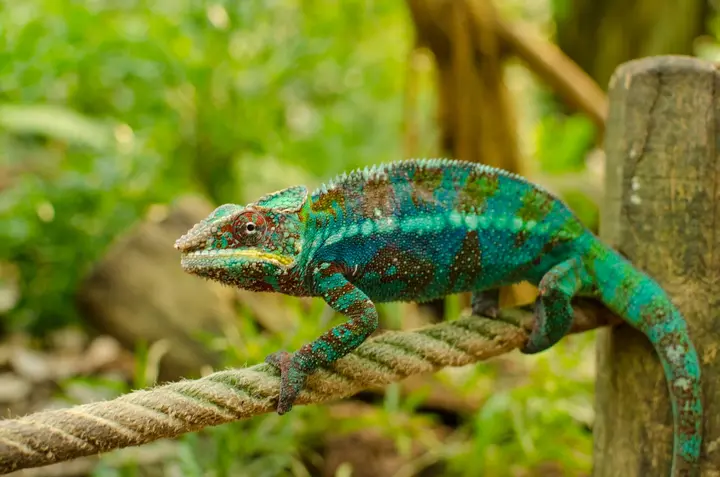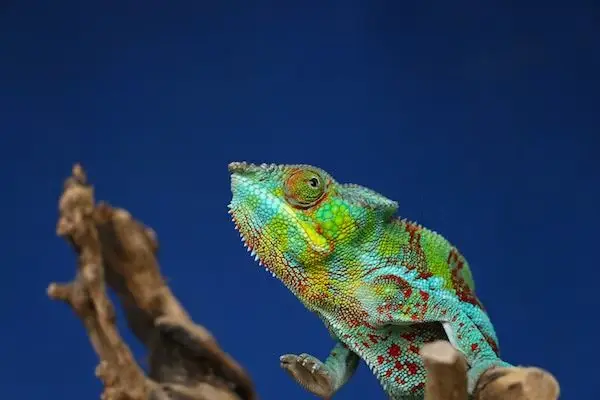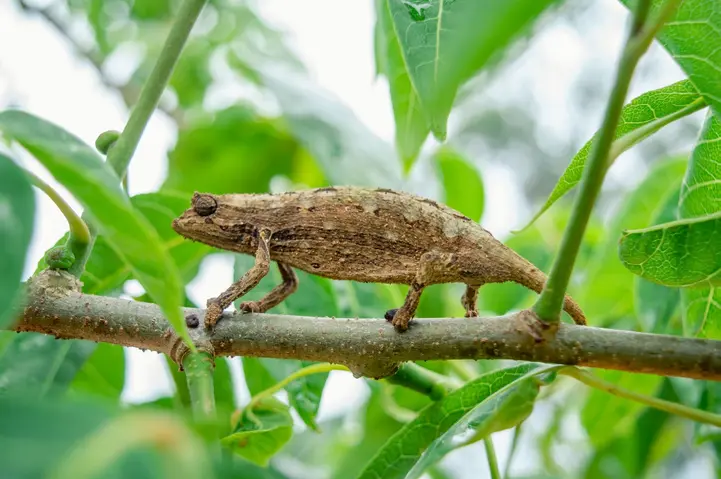Chameleons: masters of adaptation - how do they live in diverse habitats?

Chameleons are unique and amazing animals, with an amazing ability to adapt to different habitats. Chameleons are found all over the world, whether it's desert, plains, high grasses, or even in rainforests. Although chameleons adapt easily to their environments, they face numerous challenges that require them to adapt and survive.
Show key points
- Chameleons possess extraordinary adaptability, allowing them to thrive in diverse habitats such as deserts, rainforests, aquatic environments, and even urban areas.
- In harsh desert conditions, chameleons survive extreme temperatures and dehydration by storing water in their bodies and using skin adaptations to regulate heat.
- The dense vegetation and abundant resources in rainforests enable chameleons to flourish through effective camouflage, diverse feeding habits, and moisture-resistant skin.
- ADVERTISEMENT
- Aquatic chameleons show impressive swimming abilities, utilizing their sleek bodies and tails to navigate water and skillfully hunt aquatic prey.
- Their remarkable color-changing abilities serve not only as camouflage but also as a means of self-defense and predator deterrence through altering shades and complex patterns.
- Urban environments are no exception for chameleons, as they creatively adapt to new challenges by utilizing city structures and artificial resources for shelter and sustenance.
- The chameleon’s ability to adjust quickly and efficiently to continuously changing environments illustrates the broader themes of resilience and the power of natural adaptation.
Chameleon's adaptation to deserts: the power of survival in harsh conditions

In a world of arid and harsh deserts, chameleons appear as true heroes of survival. No matter how difficult conditions and lack of resources, chameleons can adapt and thrive in this harsh environment.
Deserts are undoubtedly a harsh environment, characterized by extreme temperatures during the day and sharp drops at night. Added to this is the lack of water and food in these arid regions. However, chameleons are not incapable of surviving and thriving in this harsh environment.
Recommend
Chameleons have several amazing mechanisms that enable them to adapt to the deserts of the world. For example, some chameleons are highly tolerant to dehydration, storing water in their body for long periods. This reserve of water can provide her with the fluids necessary for survival even in the most dry conditions.
In addition, chameleons have a unique thermal endurance. Some types of chameleons use a special coating on their skin that enables them to regulate their temperature to avoid exposure to extreme heat. Some species also use their ears as a heat dissipation mechanism, as they are expanded to increase heat exchange space and cool the body.
The adaptation of chameleons in deserts is not only limited to physiological aspects, but also to their behavior and lifestyle. Chameleons use sophisticated techniques for stealth and self-defense in this harsh environment. Thanks to its diverse colors and harmony with sand and rocks, chameleons are difficult to see and are considered completely hidden. When you feel threatened, you have the ability to camouflage and move quickly to escape.
But the challenges facing chameleons in deserts are not few. The search for food and water is an ongoing challenge, and navigating between different locations requires solid mentoring skills. In addition, chameleons must face threats from predators found in deserts, such as snakes and hyenas.
Chameleon's adaptation to rainforests: taking advantage of the abundance of natural resources

Rainforests are one of the most diverse and rich environments on Earth's natural resources. The chameleon stands out as a striking example of how these elegant reptiles adapt to this unique environment. Chameleons in rainforests are the true champions who benefit greatly from the abundance of resources, be it the tropical rainforests of the Amazon or the Maldives.
Chameleons pick up food that is almost unlimited in this environment. It consumes insects, small mammals and other reptiles, and relies heavily on prey, which is abundant in rainforests. Energy-rich trees and plants also provide an important source of food and water for chameleons, taking advantage of the unique diversity of plants and trees found in this environment.
Besides benefiting from the rich natural resources of the rainforest, chameleons are also distinguished by their remarkable color skills. They use these skills as a mechanism for concealment and self-defense in this dense vegetation environment. Thanks to these professional color tactics, chameleons are able to hide perfectly and merge between trees and leaves, providing them with protection and safety in the rainforest.
In addition, chameleons adapt to the humid and temperate conditions found in rainforests. Her scaled skin gives her extra protection and moisture resistance, making her live comfortably in this refreshing and water-rich environment.
Chameleon's adaptation to aquatic environments: swimming champion and skilled fisherman

Chameleons are among the most prominent creatures that can adapt wonderfully to different aquatic environments. These reptiles are distinguished by their excellent swimming skills, as they are able to maneuver lightly and quickly in the water. Thanks to its pointed body and long tail, the chameleon moves through the water with great agility and a high ability to respond to environmental changes.
The chameleon's adaptation to aquatic environments makes it a very skilled hunter. Chameleons use their ability to jump and immerse themselves for effective hunting. Chameleons wait patiently in freezing water, and as soon as their prey appears, they pounce on them very quickly and with extreme precision. Some species are skilled in using their bodies as fishing tools, using their tails to repel fish and to distance barriers.
In addition to their ingenious hunting capabilities, chameleons have exceptional abilities to adapt to aquatic environments. They are able to effectively control their balance while swimming, allowing them to stay away from hazards and maintain stability in the water. Chameleons also have special glands that allow them to spread their shells and hard shields, which is the nature of defending themselves from enemies and predators.
Chameleons' amazing adaptability to aquatic environments makes them amazing creatures with their unique abilities. Her amazing physique and outstanding swimming and fishing skills hold important lessons about nature's strength, adaptability and survival in water-challenged environments.
Chameleon's color skills: effectively defend and hide

Chameleons have amazing color skills that enable them to defend themselves and effectively hide in their surrounding environment. The ability to change their color and adapt to their background is one of the most prominent survival strategies of these unique creatures.
When a chameleon feels threatened, her body begins to interact with the environment around her. The color cells in their skin, called chromatophorates, are used to reflect and absorb light in a way that makes chameleons harmonize with the background of where they are. In this way, the chameleon manages itself to appear as an integral part of its surroundings.
Chameleons rely on a variety of colors and patterns for different purposes. For example, some species use bright and bright colors to scare away and warn of potential predators. Some patterns integrate the chameleon with the surrounding terrain, giving it more protection and camouflage.
In addition to changing colors, some chameleons are known for their ability to produce complex patterns on their body, making them difficult to notice by predators. These patterns cause confusion and suspicion in the predator, making him feel unable to accurately locate the chameleon.
In the event of an immediate threat, some chameleons may adopt additional defense strategies. Among these strategies is bulging and significantly expanding their body, making them appear larger and scaring away potential predators. They may also move quickly and magnificently, relying on their rapid movements to escape and camouflage effectively.
Chameleon adaptation in the city: the survival of the strongest in urban environments

Chameleons are among the powerful and amazing organisms with an amazing ability to adapt to their diverse habitats, and this is not exceptional in urban environments. When we talk about urbanism, we usually think that this environment is not suitable for natural creatures, but chameleons have proven their amazing presence and ability to survive and thrive in this challenging and rapidly changing environment.
The adaptation of chameleons in the city is amazing, as it relies on a variety of strategies to survive in this environment full of risks and challenges. You may find chameleons in parks, among stones and fences, and even in cliffs between buildings.
The city's chameleons rely on their amazing natural adaptability abilities. To take advantage of available resources, they have the ability to desperately search for food, where you can see them climbing trees or sneaking among the grass to get their prey. Chameleons also don't hesitate to devise new ways to survive in the urban environment, where they can find them hiding in small openings and exploiting the city's infrastructure for protection.
In addition to their ability to survive unwaveringly, the adaptation of chameleons in the city is a testament to the challenges of constant change in the environment. Chameleons are rapidly adapting to the modern technologies cities use in lighting and heating, and have even developed ways to take advantage of the new water sources that the city provides. Its quick adaptation and flexibility in adaptation reflect its ability to adapt to any challenge it faces along the way.

As masters of adaptation, chameleons are vivid examples of nature's strength, adaptability and endurance. Chameleons easily adapt to their diverse habitats, using their unique skills to survive in challenging environments. Thanks to its amazing adaptation, the chameleon was able to continue to live and thrive for millions of years. It is a powerful reminder of the importance of adaptation and resilience in our ever-changing world.








